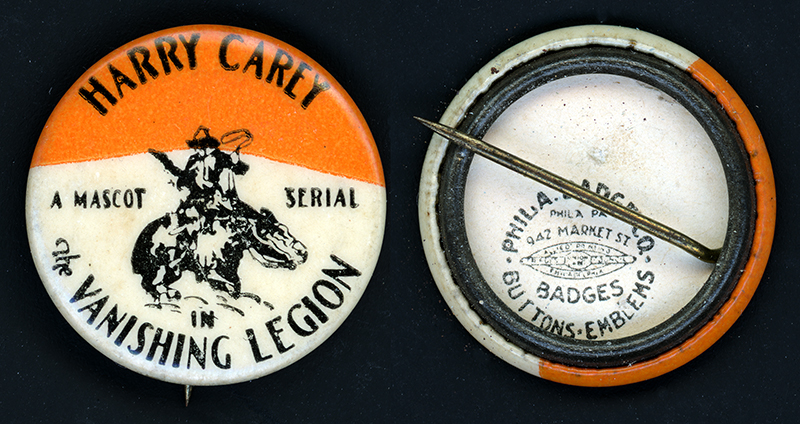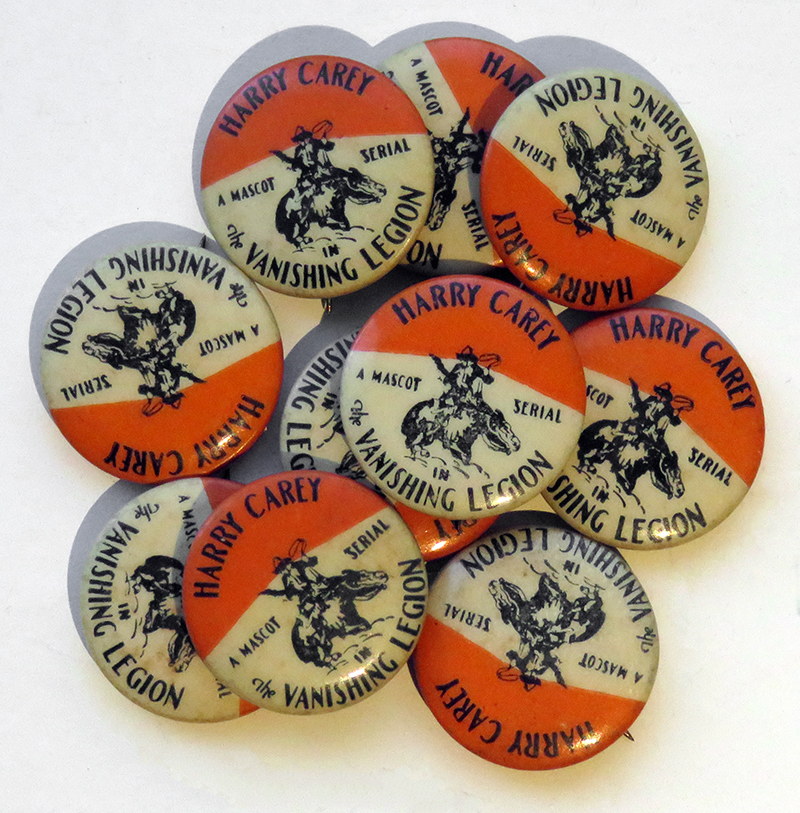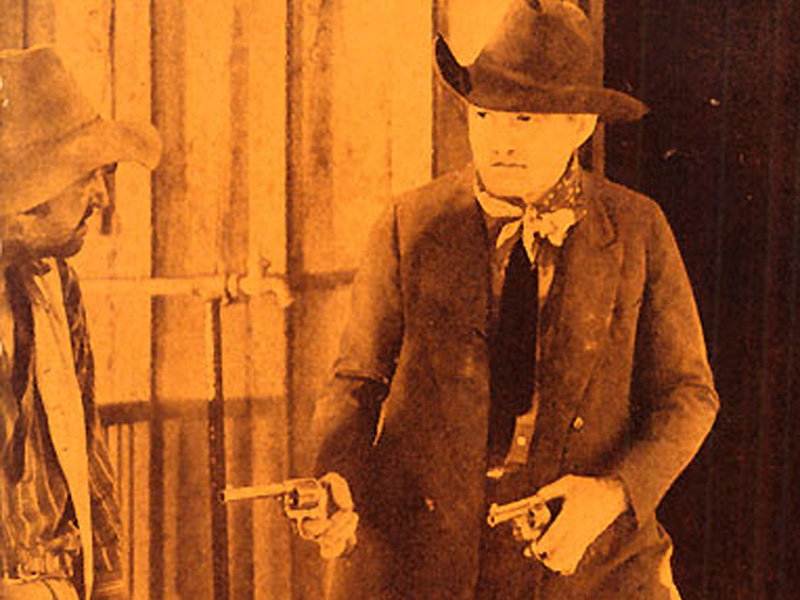|
|


Click image to enlarge
Pinback button, 7/8 inches, promoting the 12-part Mascot serial, "The Vanishing Legion" (1931), starring Harry Carey Sr. and Edwina Booth. Pinback by Philadelphia Badge Co., 942 Market Street.
Back from their overly ambitious and expensive African adventure, the Santa Clarita Valley's own Harry and Olive Carey wasted little time in getting to work on producer Nat Levine's strange 12-part serial, "The Vanishing Legion." With a total runtime of 220 minutes, production started in May 1931, and the entire picture was completed in just 18 days. Mascot Pictures' second feature of the year, it was shot largely on the Prudential lot near Newhall (note: we don't know where the Prudential lot was), while the bad guys' hangout was the Universal lot in Studio City. In the story, the bad guys do the bidding of The Voice, a disembodied and uncredited villain (spoiler: it's the voice of Boris Karloff) who directs them to steal an oil company out from under its rightful heir (played by Edwina Booth). The story uses the triad hero device, where the heroes are Harry Carey, his horse Rex (billed as "The King of Wild Horses"), and 14-year-old Frankie Darrow (1917-1976) — who was paid $1,000 for his work in "The Vanishing Legion" and whose lengthy acting career would include the role of Robbie the Robot in 1956's "The Forbidden Planet." Booth, born in Provo, Utah, in 1904, had been a $75-a-week actress on M.G.M.'s "Trader Horn," which proved to be profitable despite its cost in money ($1.3 million) and lives (one crew member was eaten by a crocodile, and another was fatally gored by a charging rhino. The latter footage was used in the film). But Booth's newfound stardom was short-lived. While paired again with Harry Carey on "The Vanishing Legion," she was in the process of suing M.G.M. for $10 million for the "jungle disease" (probably malaria) she allegedly contracted in Africa. Gossips on the Mascot set believed it a cover for a miscarriage or abortion (Tuska 1982:33), but Hollywood legend holds that she really was ill, and that it took her five or six years to recover. In any event, M.G.M. settled out of court, and Booth's acting career was finished by 1932. She married twice, outlived both husbands, spent her later years working at the Los Angeles Mormon Temple, and died in 1991. Meanwhile, Harry's wife, Oliver Fuller Golden Carey, appears on screen only in Chapters 9-12 of "The Vanishing Legion," but she was on set nearly every day if for no other reason than her husband didn't know how to drive. She drove him to and from work. Harry appears to drive a car in "The Vanishing Legion," but in fact he's just steering a car that is being pulled by ropes (ibid.:39). "The Vanishing Legion" wouldn't be what it is without actor-stuntman Yakima Canutt, who filled the role of second unit director. For the action sequences, the script said simply, "See Yak," and he filled in the blanks. Plus, Yak had worked on the 1926 Hal Roach picture, "The Devil Horse," which was shot on the same lot near Newhall, so he was able to take footage from the earlier film and insert it seamlessly into "The Vanishing Legion" where needed. It was common practice to borrow sequences from other films in those days. Rounding out the cast are William Desmond, Philo McCullough, Joe Bonomo, Tom Dugan, Lafe McKee, Bob Kortman, Edward Hearn, Paul Weigel, Frank Brownlee, Robert Walker, Al Taylor, Dick Dickinson, Pete Morrison, Dick Hatton, Tracy Layne, Cliff Lyons, Bud McClure, Walter Miller, Bob Reeves, Charles Schaeffer and Bill Wolfe. "The Vanishing Legion" is directed by Ford Beebe and B. Reeves Eason; produced by Levine; written by Wyndham Gittens, Beebe and Helmer Walton Bergman; music by Lee Zahler; cinematography by Benjamin H. Kline, Ernest Miller and Joe Novak; film editing by Wyndham Gittens; sound by Ray Snyder and George Lowerre; stunts by Canutt and Lyons. About Harry Carey Sr.
About Harry Carey Sr. Actor Harry Carey (Sr.) acquired a homestead at the mouth of San Francisquito Canyon in 1916 and established a rancho. The ranch included the Carey's wooden ranch home as well as several outbuildings and the Harry Carey Trading Post, which was a tourist attraction that included billed entertainment from Navajo Indians and other performers, along with a store that sold Western and Indian curios. The ranch was occasionally used for filming. The Careys' son, Harry Carey Jr. (Dobe), who would follow in his father's acting footsteps, was born in the Carey ranch home in 1921. The trading post washed away in the St. Francis Dam disaster of March 1928 and was not rebuilt. The Indians left about a month earlier, son Dobe said in a 2005 interview. Dobe said a shaman saw "a big crack and predicted it would break." The ranch house was situated at a higher elevation and survived the flood, only to burn down in 1932. The Careys replaced it by building a Spanish adobe home, which they sold with the rancho in 1945. Harry Carey was born Henry DeWitt Carey II on January 16, 1878 on 116th Street in the Bronx section of New York City. His father was a special-sessions judge and president of a sewing machine company. Harry attended a military academy but declined an appointment to West Point, instead trying his hand as a playwright. According to the Internet Movie Database: In 1911, his friend Henry B. Walthall introduced him to director D.W. Griffith, for whom Carey was to make many films. Carey married twice [correx: 3 times; see here], the [third] time to actress Olive Fuller Golden (aka Olive Carey), who introduced him to future director John Ford. Carey influenced Universal Studios head Carl Laemmle to use Ford as a director, and a partnership was born that lasted until a rift in the friendship in 1921. During this time, Carey grew into one of the most popular Western stars of the early motion picture, occasionally writing and directing films as well. In the 1930s he moved slowly into character roles and was nominated for an Oscar for one of them, the president of the Senate in "Mr. Smith Goes to Washington" (1939). He worked once more with Ford, in "The Prisoner of Shark Island" (1936), and appeared once with his son, Harry Carey Jr., in Howard Hawks' "Red River" (1948). He died Sept. 21, 1947, in Brentwood, after a protracted bout with emphysema and cancer. Ford dedicated his remake "3 Godfathers" (1948) "To Harry Carey — Bright Star Of The Early Western Sky." Carey would appear in at least 233 films, including short features, between 1909 and 1949. Further reading: Harry Carey Ranch: Historic American Buildings Survey No. CA-2712. About Olive Fuller Carey. Olive Carey, wife of silent film star Harry Carey and mother of actor Harry Carey Jr., was born Olive Fuller Golden on Jan. 31, 1896, in New York City. She made her first known screen appearance in 1912, when she was 16, in a one-reeler for Selig Polyscope called "The Vintage of Fate." That was followed in 1913 by two D.W. Griffith pictures for Biograph: "The Perfidy of Mary" starring Dorothy Gish, and "The Sorrowful Shore" starring the man Olive would marry in 1916. He was 18 years her elder. With the marriage, Olive quit motion pictures, and before the year was out, the couple moved onto a homestead at the mouth of San Francisquito Canyon in Saugus. While Harry continued along his path to movie stardom, the couple ran the Saugus property as a working ranch with occasional filming and eventually turned it into a tourist trap with a trading post staffed, among others, by Navajo Indians who lived on the property. In 1921 Olive gave birth to their first child, Harry Carey Jr. (aka Dobe), followed in 1923 by Ella Carey (aka Cappy). Olive sent them to Newhall School. Olive came out of retirement in 1931 when the family trekked to East Africa to make the feature "Trader Horn" for Irving Thalberg at MGM. She appeared in a couple episodes of the 12-part serial "The Vanishing Legion" starring her husband, and worked a bit more until 1935 when she retired for a second time. In the 1940s, Dobe was away in the Navy and Harry and Olive Carey were spending much of their time in New York. They never rebuilt the trading post after it was wiped out in the St. Francis Dam Disaster of 1928. They did rebuild the main house after it burned down in 1932, but by 1945 the Saugus property had outlived its usefulness to them and they sold it. Following Harry Sr.'s death in 1947, Olive returned to the screen in the 1951 Howard Hughes picture, "The Whip Hand." She had many more film and television roles (e.g., "The Searchers" and "The Alamo" on the big screen and "Wagon Train," "The Rifleman" and "Dragnet" on the small screen) before ending her career once and for all in 1966, when she was 70, in the John Carradine vehicle, "Billy the Kid vs. Dracula," in which Olive's son also appeared. (It wasn't the first time; the two had been paired a decade earlier in "The Searchers.") Olive Carey lived out her days in Carpinteria, where she died March 13, 1988 — the 60th anniversary of the flood that wiped out the trading post and swept away at least 431 people. She was 92.
LW2881: 9600 dpi jpeg of original pinback purchased 2017 by Leon Worden.
|
FULL MOVIE:
Broken Ways 1913
FULL MOVIE 1938
Fan Reply Card <1928
Marriages
Marked Men 1919
A Fight for Love 1919
Harry & Olive 1919
Overland Red 1920
Canyon of the Fools 1923
The Seventh Bandit 1926 (Mult.)
Satan Town 1926
Burning Bridges 1928
Trader Horn 1931
The Vanishing Legion 1931 (Mult.)
The Devil Horse 1932
Rustler's Paradise 1935
Last of the Clintons 1935
Port of Missing Girls 1938
With U.S. VP John Garner 1940
The Shepherd of the Hills 1941 (Mult.)
Hollywood Walk of Fame
Nat Levine 1988
|
The site owner makes no assertions as to ownership of any original copyrights to digitized images. However, these images are intended for Personal or Research use only. Any other kind of use, including but not limited to commercial or scholarly publication in any medium or format, public exhibition, or use online or in a web site, may be subject to additional restrictions including but not limited to the copyrights held by parties other than the site owner. USERS ARE SOLELY RESPONSIBLE for determining the existence of such rights and for obtaining any permissions and/or paying associated fees necessary for the proposed use.


























